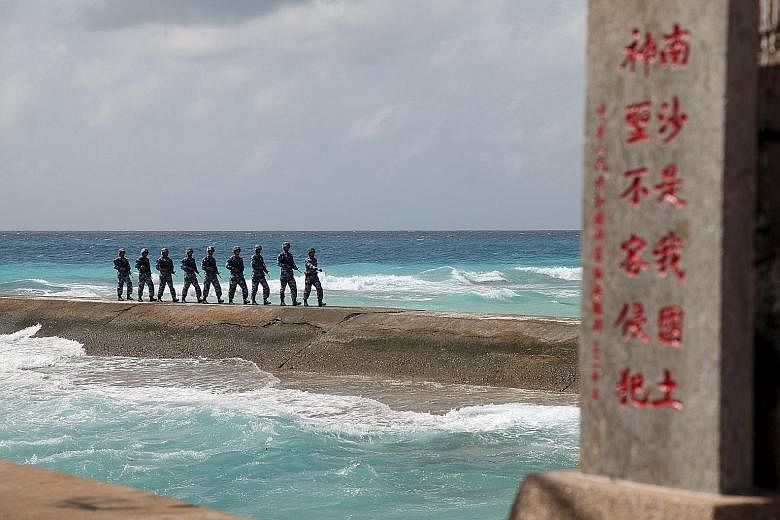WASHINGTON • The militarisation of facilities in the South China Sea does not help efforts to resolve maritime claims, United States Secretary of State John Kerry said, after satellite images released by a US think-tank showed China may be installing a powerful radar system on a disputed island in the Spratlys.
The US is "encouraging the peaceful resolution of competing maritime claims in the South China Sea - a goal that is definitely not helped by the militarisation of facilities in that region," Mr Kerry told lawmakers in congressional testimony yesterday before he is due to meet Chinese Foreign Minister Wang Yi, Reuters reported.
The images released by the Washington-based Centre for Strategic and International Studies (CSIS) appeared to show a high-frequency radar installation going up on Cuarteron Reef, The Washington Post reported earlier yesterday.
Cuarteron Reef is one of seven islands China has recently expanded through a massive land reclamation programme in the Spratly chain.
"If it is an HF (high-frequency) radar, then it would enormously boost China's capacity to monitor ships and aircraft in the South China Sea," said Mr Gregory Poling, head of the Asia Maritime Transparency Initiative at CSIS.
"This would be very important in a Chinese anti-access area denial strategy that sought to reduce the ability of the US to operate freely in the South China Sea, including bringing forces up through the South China Sea in case of any future crisis in North-east Asia."
Just last week, US officials said China had deployed surface-to-air missiles on Woody Island in the Paracels farther north, sparking concern about the growing militarisation of the South China Sea.
The South China Sea issue is likely to figure high on talks between Mr Kerry and Mr Wang, the other top issue being North Korea.
China last night reaffirmed its right to self-defence and refuted US charges as "hyping with ulterior motives", the official Xinhua news agency reported.
Washington's recent air and sea patrols near islands claimed by Beijing in the South China Sea have angered China.
The deployment of defence facilities is the result of China's right to self-defence granted by international law, Xinhua reported, quoting a press statement from the Ministry of National Defence.
The Washington Post said other photographs supplied by CSIS show radar facilities being built on other islands in the Spratlys, which are also claimed in full or in part by Brunei, Malaysia, the Philippines, Taiwan and Vietnam.
Some analysts see the developments as tilting the balance in China's favour.
"It looks like China isn't leaving anything for the imagination by transforming every land feature under its control into an integral part of a broader military complex in the South China Sea," Assistant Professor Richard Javad Heydarian of De La Salle University in Manila told The Straits Times. All these will enable it "to better monitor and protect its air patrols", he said.
"It very much looks like the skeleton of an air defence identification zone," he added.
Professor Ni Lexiong, a naval expert at the Shanghai University of Political Science and Law, said that while it has not been confirmed whether it is a civilian or military radar system, it is only a matter of time before China installs a military radar.
"(It) is within our country's right to do so on our territory. There is a need to install a military radar system in the South China Sea for self- defence needs, especially since American ships and planes are now operating within our territory and even close to our coastline," he told The Straits Times.


